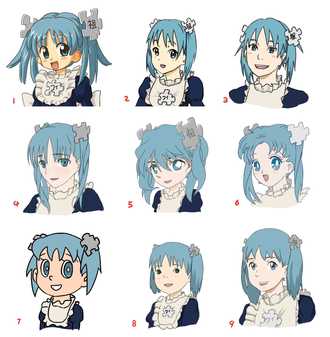In 1917, the first professional and publicly displayed works began to appear; animators such as Ōten Shimokawa, Seitarō Kitayama, and Jun'ichi Kōuchi (considered the "fathers of anime") produced numerous films, the oldest surviving of which is Kōuchi's Namakura Gatana.

Anime (Japanese: アニメ, IPA: [aꜜɲime] ⓘ) is hand-drawn and computer-generated animation originating from Japan. Outside Japan and in English, anime refers specifically to animation produced in Japan.[1] However, in Japan and Japanese, anime (a term derived from a shortening of the English word animation) describes all animated works, regardless of style or origin. Many works of animation with a similar style to Japanese animation are also produced outside Japan. Video games sometimes also feature themes and art styles that are sometimes labelled as anime.
The earliest commercial Japanese animation dates to 1917. A characteristic art style emerged in the 1960s with the works of cartoonist Osamu Tezuka and spread in following decades, developing a large domestic audience. Anime is distributed theatrically, through television broadcasts, directly to home media, and over the Internet. In addition to original works, anime are often adaptations of Japanese comics (manga), light novels, or video games. It is classified into numerous genres targeting various broad and niche audiences.[2]
Anime is a diverse medium with distinctive production methods that have adapted in response to emergent technologies. It combines graphic art, characterization, cinematography, and other forms of imaginative and individualistic techniques.[3] Compared to Western animation, anime production generally focuses less on movement, and more on the detail of settings and use of "camera effects", such as panning, zooming, and angle shots.[3] Diverse art styles are used, and character proportions and features can be quite varied, with a common characteristic feature being large and emotive eyes.[4]
The anime industry consists of over 430 production companies, including major studios such as Studio Ghibli, Kyoto Animation, Sunrise, Bones, Ufotable, MAPPA, Wit Studio, CoMix Wave Films, Production I.G, and Toei Animation. Since the 1980s, the medium has also seen widespread international success with the rise of foreign dubbed, subtitled programming, and since the 2010s due to the rise of streaming services and a widening demographic embrace of anime culture, both within Japan and worldwide.[5] As of 2016, Japanese animation accounted for 60% of the world's animated television shows.[6]

Manga (漫画, IPA: [maŋga] ⓘ[a]) are comics or graphic novels originating from Japan.[1] Most manga conform to a style developed in Japan in the late 19th century,[2] and the form has a long history in earlier Japanese art.[3] The term manga is used in Japan to refer to both comics and cartooning. Outside of Japan, the word is typically used to refer to comics originally published in Japan.
In Japan, people of all ages and walks of life read manga. The medium includes works in a broad range of genres: action, adventure, business and commerce, comedy, detective, drama, historical, horror, mystery, romance, science fiction and fantasy, erotica (hentai and ecchi), sports and games, and suspense, among others.[4][5] Many manga are translated into other languages.[6][7]
Since the 1950s, manga has become an increasingly major part of the Japanese publishing industry.[8] By 1995, the manga market in Japan was valued at ¥586.4 billion ($6–7 billion),[9] with annual sales of 1.9 billion manga books and manga magazines (also known as manga anthologies) in Japan (equivalent to 15 issues per person).[10] In 2020 Japan's manga market value hit a new record of ¥612.6 billion due to the fast growth of digital manga sales as well as increase of print sales.[11][12] In 2022 Japan's manga market hit yet another record value of ¥675.9 billion.[13][14] Manga have also gained a significant worldwide readership.[15][16][17][18] Beginning with the late 2010s manga started massively outselling American comics.[19]
As of 2021, the top four comics publishers in the world are manga publishers Shueisha, Kodansha, Kadokawa, and Shogakukan.[20] In 2020 the North American manga market was valued at almost $250 million.[21] According to NPD BookScan manga made up 76% of overall comics and graphic novel sales in the US in 2021.[22] The fast growth of the North American manga market is attributed to manga's wide availability on digital reading apps, book retailer chains such as Barnes & Noble and online retailers such as Amazon as well as the increased streaming of anime.[23][24][25] Manga represented 38% of the French comics market in 2005.[26] This is equivalent to approximately three times that of the United States and was valued at about €460 million ($640 million).[27] In Europe and the Middle East, the market was valued at $250 million in 2012.[28] In April 2023, the Japan Business Federation laid out a proposal aiming to spur the economic growth of Japan by further promoting the contents industry abroad, primarily anime, manga and video games, for measures to invite industry experts from abroad to come to Japan to work, and to link with the tourism sector to help foreign fans of manga and anime visit sites across the country associated with particular manga stories. The federation seeks on quadrupling the sales of Japanese content in overseas markets within the upcoming 10 years.[29][30]
Manga stories are typically printed in black-and-white—due to time constraints, artistic reasons (as coloring could lessen the impact of the artwork)[31] and to keep printing costs low[32]—although some full-color manga exist (e.g., Colorful). In Japan, manga are usually serialized in large manga magazines, often containing many stories, each presented in a single episode to be continued in the next issue. A single manga story is almost always longer than a single issue from a Western comic.[33] Collected chapters are usually republished in tankōbon volumes, frequently but not exclusively paperback books.[34] A manga artist (mangaka in Japanese) typically works with a few assistants in a small studio and is associated with a creative editor from a commercial publishing company.[35] If a manga series is popular enough, it may be animated after or during its run.[36] Sometimes, manga are based on previous live-action or animated films.[37]
Manga-influenced comics, among original works, exist in other parts of the world, particularly in those places that speak Chinese ("manhua"), Korean ("manhwa"), English ("OEL manga"), and French ("manfra"), as well as in the nation of Algeria ("DZ-manga").[38][39]

